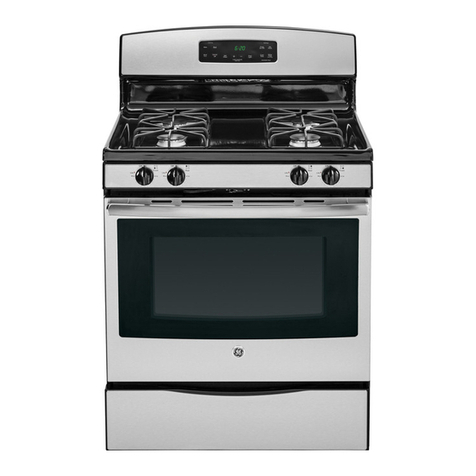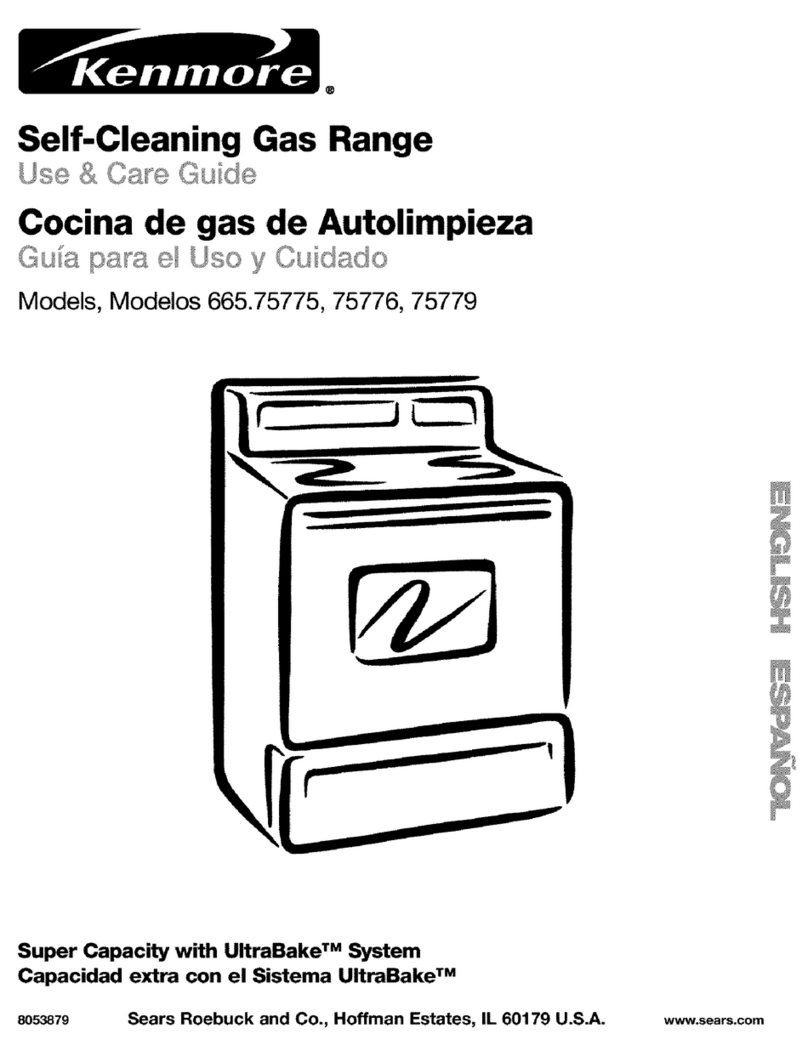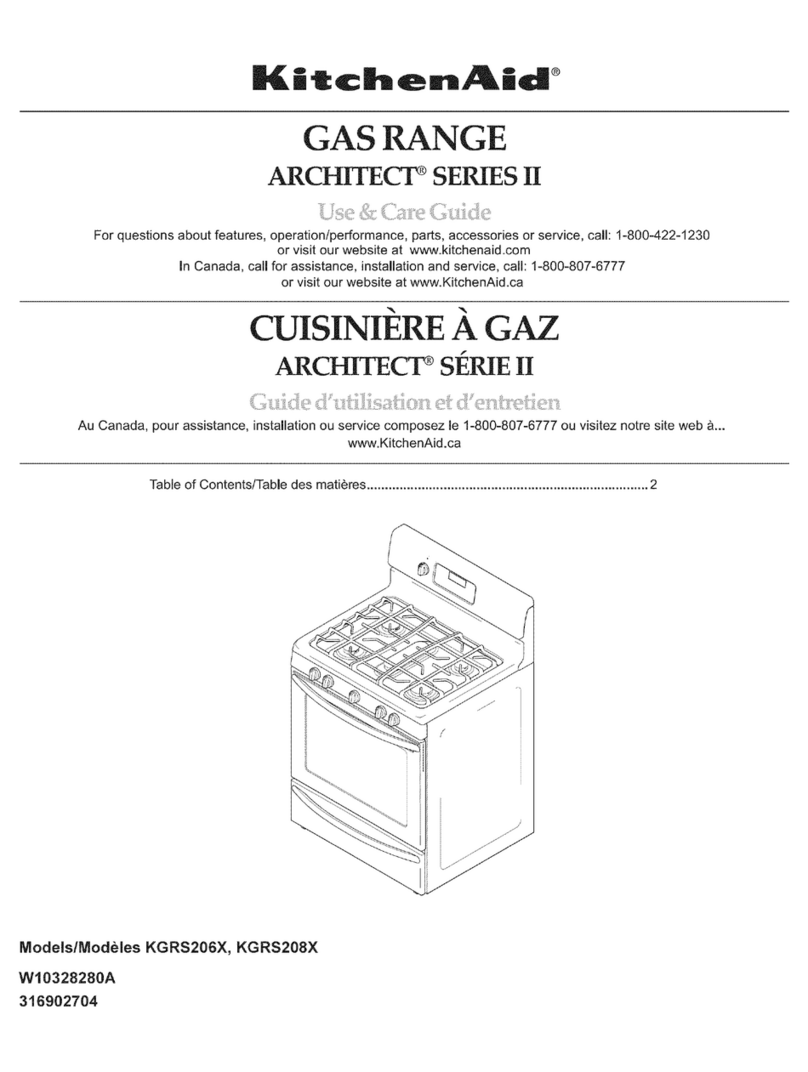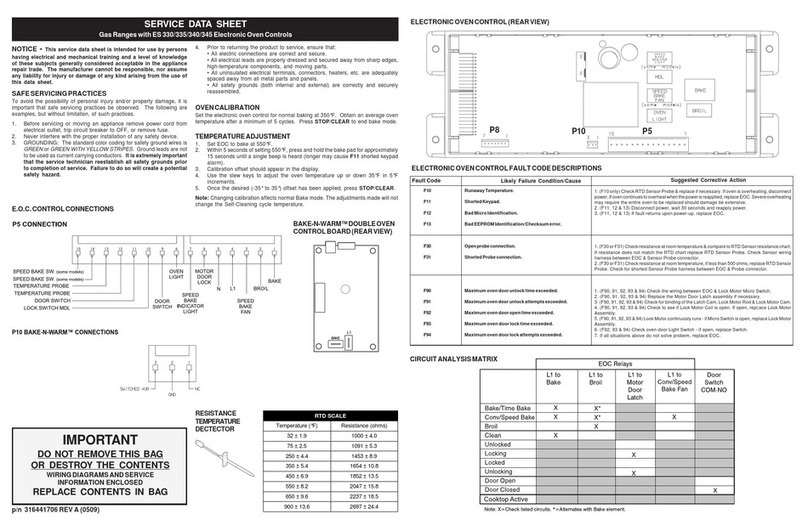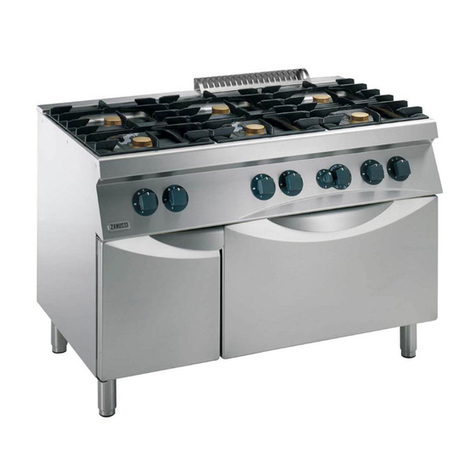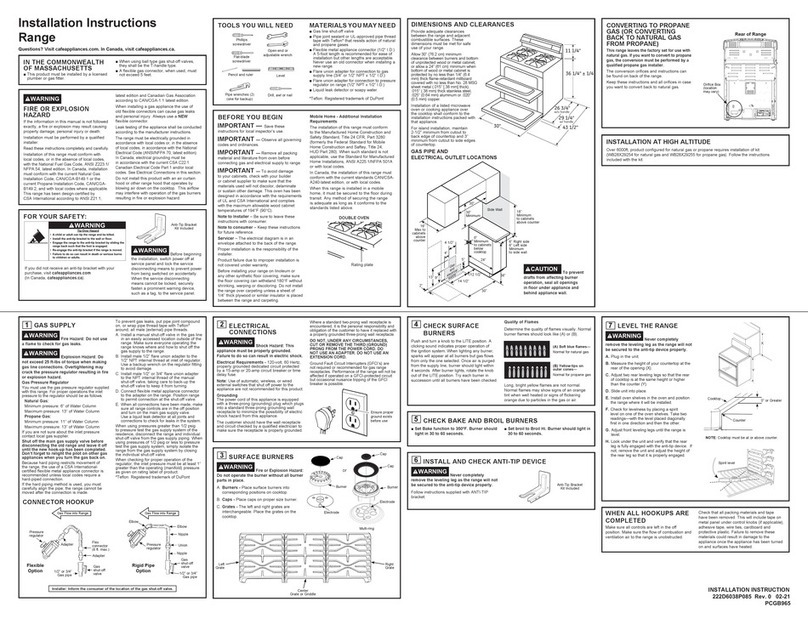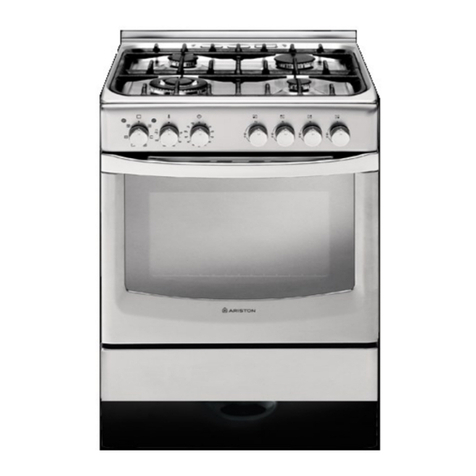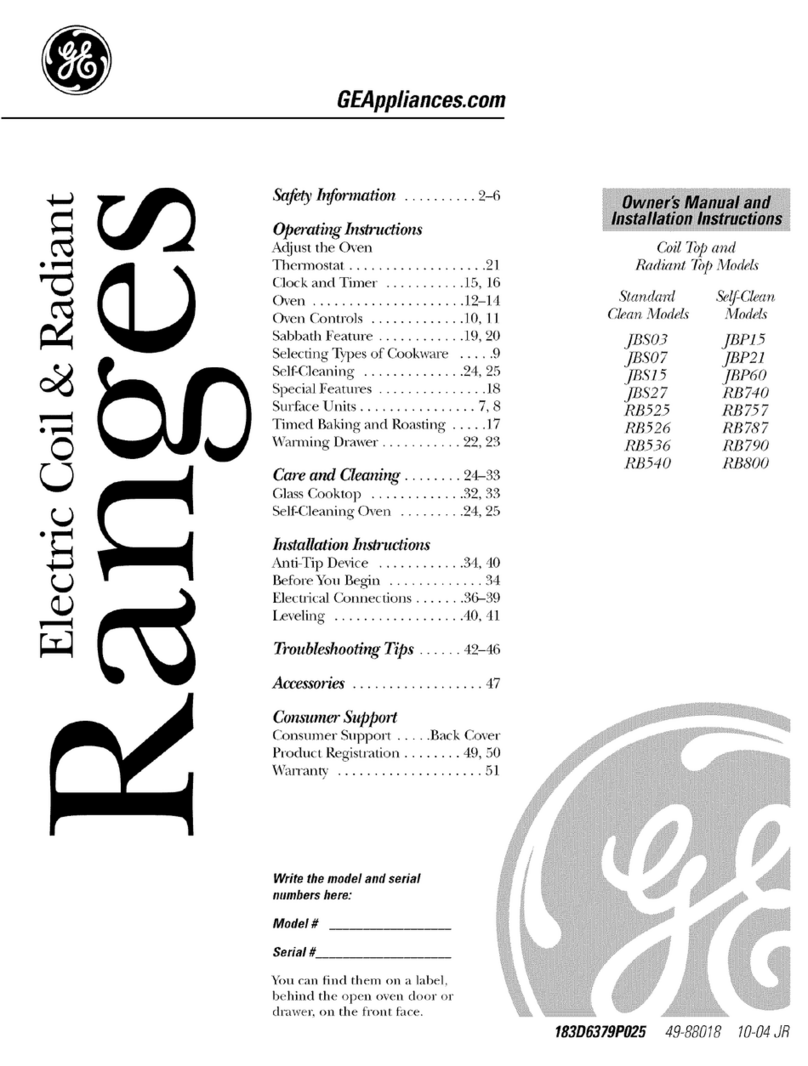DèLonghi D3VR 908-DF Operating instructions

1
DE’LONGHI
COOKING
USER & INSTALLATION INSTRUCTIONS
D3VR 908-DF
DUAL FUEL TRIPLE OVEN COOKER
GB

2
CONTENTS
Page Number
Introduction............................................... 3
Important Safeguards & Recommendations ..................... 4-8
Cooking Hob ............................................. 9
Control Panel .............................................10
Use of hob burners ........................................11 - 13
How to use the multifunction bottom main oven .................14 - 17
How to use the top small grill................................18
How to use the tall oven....................................19 - 20
Oven temperature guide ....................................21
Electronic programmer......................................22 - 27
Cleaning & maintenance ....................................28 - 39
Advice For The Installer ....................................40
Installation ...............................................41 - 44
Gas installation ...........................................45 - 50
Electrical section ..........................................51 - 52
Guarantee & After Sales Service .............................53

3
IMPORTANT INFORMATION FOR CORRECT DISPOSAL OF THE PRODUCT
IN ACCORDANCE WITH EC DIRECTIVE 2012/19/EC.
At the end of its working life, the product must not be disposed of as
urban waste. It must be taken to a special local authority differentiated
waste collection centre or to a dealer providing this service.
Disposing of a household appliance separately avoids possible
negative consequences for the environment and health deriving from
inappropriate disposal and enables the constituent materials to be
recovered to obtain signicant savings in energy and resources. As a
reminder of the need to dispose of household appliances separately,
the product is marked with a crossed-out wheeled dustbin.
Dear Customer,
Thank you for purchasing a DeLonghi D3VR 908-DF dual fuel
triple oven cooker.
The safety precautions and recommendations reported below
are for your own safety and that of others. They will also provide
a means by which to make full use of the features offered by your
appliance.
Please preserve this booklet carefully. It may be useful in
future, either to yourself or to others in the event that doubts
should arise relating to its operation.
This appliance must be used only for the task it has explicitly
been designed for, that is for cooking foodstuffs. Any other
form of usage is to be considered as inappropriate and
therefore dangerous.
The manufacturer declines all responsibility in the event of
damage caused by improper, incorrect or illogical use of the
appliance.
DECLARATION OF CE CONFORMITY
• This appliance has been designed to be used only for cooking. Any other use (such as
heating a room) is improper and dangerous.
• This appliance has been designed, constructed, and marketed in compliance with:
- Safety requirements of the “Gas” Directive 2009/142/EC;
- Safety requirements of the “Low voltage” Directive 2014/35/EU;
- Safety requirements of the “EMC” Directive 2014/30/EU;
- Requirements of EU Directive 93/68/EEC;
- Requirements of EU Directive 2011/65/EU.
GB

4
IMPORTANT SAFETY PRECAUTIONS AND RECOMMENDATIONS
IMPORTANT: This appliance is designed and manufactured
solely for the cooking of domestic (household) food and is
not suitable for any non domestic application and therefore
should not be used in a commercial environment.
The appliance guarantee will be void if the appliance is used
within a non domestic environment i.e. a semi commercial,
commercial or communal environment.
Read the instructions carefully before installing and using
the appliance.
• After having unpacked the appliance, check to ensure that it is not
damaged and that the oven door closes correctly.
In case of doubt, do not use it and consult your supplier or a
professionally qualied technician.
• Packing elements (i.e. plastic bags, polystyrene foam, nails, packing
straps, etc.) should not be left around within easy reach of children,
as these may cause serious injuries.
• Some appliances are supplied with a protective lm on steel and
aluminium parts. This lm must be removed before using the
appliance.
• IMPORTANT: The use of suitable protective clothing/gloves is
recommended when handling or cleaning of this appliance.
• Do not attempt to modify the technical characteristics of the appliance
as this may become dangerous to use. The manufacturer declines all
responsability for any inconvenience resulting from the inobservance
of this condition.
• CAUTION: this appIiance must only be installed in a permanently
ventilated room in compliance with the applicable regulations.
• Do not carry out cleaning or maintenance operations on the appliance
without having previously disconnected it from the electric power
supply.
• WARNING: Ensure that the appliance is switched off before replacing
the oven lamp to avoid the possibility of electric shock.
• Do not use a steam cleaner because the moisture can get into the
appliance thus make it unsafe.

5
• Do not touch the appliance with wet or damp hands (or feet).
• Do not use the appliance whilst in bare feet.
• If you should decide not to use this appliance any longer (or decide to
substitute another model), before disposing of it, it is recommended
that it be made inoperative in an appropriate manner in accordance to
health and environmental protection regulations, ensuring in particular
that all potentially hazardous parts be made harmless, especially in
relation to children who could play with unused appliances.
• The various components of the appliance are recyclable. Dispose of
them in accordance with the regulations in force in your country. If the
appliance is to be scrapped, remove the power cord.
• After use, ensure that the knobs are in the off position.
• Children less than 8 years of age shall be kept away unless
continuously supervised.
• This appliance can be used by children aged from 8 years and above
and persons with reduced physical, sensory or mental capabilities or
lack of experience and knowledge if they have been given supervision
or instruction concerning use of the appliance in a safe way and
understand the hazards involved. Children shall not play with the
appliance. Cleaning and user maintenance shall not be made by
children without supervision.
• The manufacturer declines all liability for injury to persons or damage
to property caused by incorrect or improper use of the appliance.
• WARNING: During use the appliance and its accessible parts become
hot; they remain hot for some time after use.
– Care should be taken to avoid touching heating elements (on the
hob and inside the oven).
– The door is hot, use the handle.
– To avoid burns and scalds, young children should be kept away.
• Make sure that electrical cables connecting other appliances in the
proximity of the cooker cannot come into contact with the hob or
become entrapped in the oven door.
• WARNING: Unattended cooking on a hob with fat or oil can be
dangerous and may result in re. NEVER try to extinguish a re with
water, but switch of the appliance and then cover ame e.g. with a lid
or a re blanket.

6
• WARNING: Danger of re: do not store items on the cooking surfaces.
• WARNING: When correctly installed, your product meets all safety
requirements laid down for this type of product category. However
special care should be taken around the rear or the underneath of the
appliance as these areas are not designed or intended to be touched
and may contain sharp or rough edges, that may cause injury.
• FIRST USE OF THE OVEN - it is advised to follow these instructions:
– Furnish the interior of the oven as described at chapter “CLEANING
AND MAINTENANCE”.
– Switch on the empty oven on max to eliminate grease from the
heating elements.
– Disconnect the appliance from the electrical power supply, let the
oven cool down and clean the interior of the oven with a cloth
soaked in water and neutral detergent; then dry carefully.
• CAUTION: Do not use harsh abrasive cleaners or sharp metal
scrapers to clean the oven door glass since they can scratch the
surface, which may result in shattering of the glass.
• Do not line the oven walls or oor with aluminium foil. Do not place
baking trays or the drip tray on the base of the oven chamber.
• FIRE RISK! Do not store ammable material in the oven or in the
storage compartment.
• Always use oven gloves when removing the shelves and food trays
from the oven whilst hot.
• Do not hang towels, dishcloths or other items on the appliance or its
handle – as this could be a re hazard.
• Clean the oven regularly and do not allow fat or oils to build up in the
oven base or tray. Remove spillages as soon as they occur.
• Do not stand on the cooker or on the open oven door.
• Always stand back from the appliance when opening the oven door
to allow steam and hot air to escape before removing the food.
• SAFE FOOD HANDLING: Leave food in the oven for as short a time
as possible before and after cooking. This is to avoid contamination
by organisms which may cause food poisoning. Take particular care
during warmer weather.
• WARNING: Taking care NOT to lift the cooker by the door handle.

7
ENERGY LABELLING/ECODESIGN
• Commission delegated regulation (EU) No 65/2014 (supplementing Directive 2010/30/EU
of the European Parliament and of the Council).
• Commission regulation (EU) No 66/2014 (implementing Directive 2009/125/EC of the
European Parliament and of the Council).
Reference to the measurement and calculation methods used to establish compliance with
the above requirements:
• Standard EN 60350-1 (electric ovens).
• Standard EN30-2-1 (hobs: gas red burners).
USE OF THE APPLIANCE, ENERGY SAVING TIPS
OVEN
• Check the oven door always closes properly and the door gasket is clean and in order.
During use, open the oven door only when strictly necessary to avoid heat losses (for
some functions it may be necessary to use the oven with the door half-closed, check
the oven operating instructions).
• Turn off the oven 5-10 minutes before the end of the theoretical cooking time to
recuperate the stored heat.
• We recommend using oven proof dishes and adjusting the oven temperature during
cooking if necessary.
HOB
GAS FIRED BURNERS
• It is important that the diameter of the pot be suitable to the size of the burner so as
not to compromise the high output of the burners and therefore energy waste. A small
pot on a large burner does not give you a boiling point in a shorter amount of time
since the capacity of heat absorption of a liquid mass depends on the volume and the
surface of the pot.
• Avoid keeping a burner on without something on it (without pot).

8
This gure is indicative only
Hob rail
Door handle/s
WARNING – VERY IMPORTANT !
FIRE/OVERHEATING HAZARD:
• Do not place towels/cloths etc onto the hob rail or oven door
handle/s whilst the product is in use or hot.
TO AVOID DAMAGE TO THE APPLIANCE:
• Do not lift/move the cooker by the hob rail or oven door handle/s.
• Do not lean on the hob rail or oven door handle/s.

9
2
4
2
13
GAS BURNERS
1. Auxiliary burner (A) 1,00 kW
2. Semi-rapid burner (SR) 1,75 kW
3. Rapid burner (R) 3,00 kW
4. Triple-ring burner (TR) 4,00 kW
1 - COOKING HOB
Notes:
• The electric ignition is incorporated in the knobs.
• The appliance has a safety valve system tted, the ow of gas will be stopped if and
when the ame should accidentally go out.
CAUTION:
If the burner is accidentally extinguished, turn the gas off at the control knob and wait at
least 1 minute before attempting to relight.
CAUTION:
Gas hobs produce heat and humidity in the environment in which they are installed.
Ensure that the cooking area is well ventilated by opening the natural ventilation grilles or
by installing an extractor hood connected to an outlet duct that vents to the outside.
CAUTION:
If the hob is used for a prolonged time it may be necessary to provide further ventilation
by opening a window or by increasing the suction power of the extractor hood if tted and
vented to the outside.
Fig. 1.1

10
CONTROL PANEL - Controls description
1. Electronic programmer (main oven only)
2. Grill oven temperature knob (left small oven)
3. Multifunction oven switch knob
4. Multifunction oven thermostat knob
5. Front left burner control knob
6. Rear left burner control knob
7. Central burner control knob
8. Rear right burner control knob
9. Front right burner control knob
10. Fan oven thermostat knob (right oven)
Pilot lamps:
11. Fan oven temperature indicator light
12. Fan oven on indicator light
13. Multifunction oven temperature indicator light
14. Grill oven on indicator light
2 - CONTROL PANEL
MIN
31 2 4 5 6 7 8 9 10
11
12
A
14 13
Fig. 2.1
Please note: This appliance incorporates a safety cooling fan which you will hear operating
whenever the oven or grill is being used.
The cooling fan may even run on after the appliance has been switched off.
The duration of this time is dependent on several factors, including previous cooking
temperature, duration and ambient temperature. Times in excess of 30 minutes are not
uncommon.

11
3 - USE OF THE HOB BURNERS
GAS BURNERS
Gas ow to the burners is adjusted by
turning the knobs (illustrated in g. 3.1)
which control the safety valves.
Turning the knob, so that the indicator line
points to the symbols printed on the panel,
achieves the following functions:
- symbol closed valve
- symbol maximum
aperture or ow
- symbol minimum
aperture or ow
√The maximum aperture position
permits rapid boiling of liquids, whereas
the minimum aperture position allows
slower warming of food or maintaining
boiling conditions of liquids.
√ To reduce the gas ow to minimum
rotate the knob further anti-clockwise
to point the indicator towards the small
ame symbol.
√Other intermediate operating
adjustments can be achieved by
positioning the indicator between the
maximum and minimum aperture
positions, and never between the
maximum aperture and closed
positions.
Caution!
The cooking hob becomes very hot
during operation.
Keep children well out of reach.
N.B. When the cooker is not being
used, set the gas knobs to their closed
positions.
Fig. 3.2
Fig. 3.1

12
DEEP FAT FRYING
For safety purposes when deep fat frying,
do not ll the pan more than one third full
of oil.
DO NOT cover the pan with a lid and DO
NOT leave the pan unattended.
In the unfortunate event of a re, leave
the pan where it is and turn off the control
knobs.
Place a damp cloth or lid over the pan to
smother the ames. Leave the pan to cool
for at least 30minutes before moving the
pan.
DO NOT USE WATER ON THE FIRE.
CHOICE OF THE BURNER
On the control panel, near every knob
there is a diagram that indicates which
burner is controlled by that knob.
The suitable burner must be chosen
according to the diameter and the capacity
used.
As an indication, the burners and the pots
must be used in the following way:
DIAMETERS OF PANS WHICH MAY BE
USED ON THE BURNERS
BURNERS MINIMUM MAXIMUM
Auxiliary 12 cm 14 cm
Semi-rapid 16 cm 24 cm
Rapid 24 cm 26 cm
Triple-ring 26 cm 28 cm
Wok max 36 cm
do not use pans with concave or convex
bases
Fig. 3.3
It is important that the diameter of the pot
be suitable to the potentiality of the burner
so as not to compromise the high output
of the burners and therefore energy waste.
A small pot on a large burner does not give
you a boiling point in a shorter amount of
time since the capacity of heat absorption
of a liquid mass depends on the volume
and the surface of the pot.
LIGHTING THE BURNERS
To ignite the burner, the following
instructions are to be followed:
1. Press in the corresponding knob and
turn counter-clockwise (g. 3.2) to the
full ame position marked by the
symbol (g. 3.1); hold the knob in until
the ame has been lit.
In the case of a mains failure light the
burner with a match or lighted taper.
2. Wait for a few seconds after the gas
burner has been lit before letting
go of
the knob (valve activation delay).
3. Adjust the gas valve to the desired
position.
If the burner ame should go out for some
reason, the safety valve will automatically
stop the gas ow.
To re-light the burner, return the knob to the
closed position, wait for at least 1
minute and then repeat the lighting
procedure.
If your local gas supply makes it difcult
to light the burner with the knob set to
maximum, set the knob to minimum and
repeat the operation.

13
CORRECT USE OF THE TRIPLE-RING BURNER
Only at bottom pans of the correct size are to be placed on the pan support above the
Triple-ring burner.
When using a WOK, the supplied wok stand must be placed onto the pan stand to avoid
any faulty operation of the triple-ring burner (g. 3.4a). The wok should not be placed
directly onto the pan support without the use of the supplied wok stand (g. 3.4b).
IMPORTANT:
When using the wok stand it MUST ONLY BE PLACED over the pan support for the triple-
ring burner (g.3.4a). Under no circumstances should the wok stand be placed under
the pan supports (gs 3.5a - 3.5b). Incorrect placement of the wok stand in this manner
may impinge the ame resulting in incomplete combustion and give rise to harmful levels
of Carbon Monoxide (CO).
WRONG
Fig. 3.4b
Fig. 3.5a Fig. 3.5b
WRONG WRONG
CORRECT
Fig. 3.4a

14
GENERAL FEATURES
As its name indicates, this is an oven
that presents particular features from an
operational point of view.
In fact, it is possible to insert 7 different
programs to satisfy every cooking need.
The 7 positions, thermostatically controlled,
are obtained by 4 heating elements which
are:
• Bottom element
• Top element
• Grill element
• Circular element
NOTE:
Upon rst use, it is advisable to operate the
oven for 30 minutes in the position and
to eliminate possible traces of grease
on the heating elements.
Repeat the operation for another 15
minutes with the grill element on.
Smells and fumes produced during this
burn off process are not a cause of alarm.
Adequate ventilation should however be
provided in the room where the appliance
is installed, e.g. by opening a window.
OPERATING PRINCIPLES
Heating and cooking in the
MULTIFUNCTION oven are obtained in the
following ways:
a. by normal convection
The heat is produced by the upper and
lower heating elements.
b. by forced convection
A fan draws in the air contained in
the oven, which circulates it through
the circular heating element and then
forced back into the oven by the fan.
Before the hot air is drawn back
again by the fan to repeat the cycle,
it envelops the food in the oven,
provoking a complete and rapid
cooking. It is possible to cook several
dishes simultaneously.
c. by semi-forced convection
The heat produced by the upper and
lower heating elements is distributed
throughout the oven by the fan.
d. by radiation
The heat is radiated by the infra red
grill element.
e. by radiation and ventilation
The radiated heat from the infra red
grill element is distributed throughout
the oven by the fan.
f. by ventilation
The food is defrosted by using the fan
only function without heat.
Before introducing the food, preheat the
oven to the desired temperature.
For a correct preheating operation, it is
advisable to remove the tray from the oven
and introduce it together with the food,
when the oven has reached the desired
temperature.
Check the cooking time and turn off the
oven 5 minutes before the theoretical time
to recuperate the stored heat.
WARNING:
The door is hot, use the handle.
ATTENTION - MOST IMPORTANT
Pay special attention not to touch the
hot heating element inside the oven
cavity.
Attention: the oven door becomes
very hot during operation.
Keep children away.
4 -
HOW TO USE THE MULTIFUNCTION BOTTOM MAIN OVEN

15
Fig. 4.1 Fig. 4.2
TEMPERATURE KNOB (g. 4.2)
To turn on the heating elements of the oven, set rst the function selector to the required
setting and then the thermostat knob to the desired temperature.
To set the temperature, line up the temperature knob indicator with the required
temperature.
The elements will turn ON or OFF automatically according to the energy need which is
determined by the thermostat.
The operation of the heating elements is signalled by a light placed on the control panel.
FUNCTION SELECTOR KNOB (g. 4.1)
Rotate the knob clockwise to set the oven for one of the following functions:
OVEN LIGHT
By setting the knob to this position, only the oven light comes on.
The light remains on whilst any of the cooking modes are selected.
TRADITIONAL CONVECTION COOKING
The upper and lower heating elements are switched on. The heat is diffused by natural
convection and the temperature must be regulated between 50°C and 250°C with the
thermostat knob.
It is necessary to preheat the oven before introducing the foods to be cooked.
Recommended for:
For foods which require the same cooking temperature both internally and externally, i. e.
roasts, spare ribs, meringue, etc.
NB DO NOT place food, trays or silver foil directly onto the base of the oven as this
may damage the enamel coating of the oven.

16
GRILLING
The infra-red heating element is switched on. The heat is diffused by radiation.
Use with the oven door closed and the thermostat knob
must be regulated between 50°C
and 225°C maximum.
Preheat the oven for about 5 minutes.
Introduce the food to be cooked, positioning the rack as close to the grill as possible.
The dripping pan should be placed under the rack to catch the cooking juices and fats.
Use with the oven door closed.
Note: It is recommended that you do not grill for longer than 30 minutes at any one time.
Attention: The oven door becomes very hot during operation. Keep children away.
Recommended for:
Intense grilling action for browning, crisping, “au gratin”, toasting, etc.
DEFROSTING FROZEN FOODS
Only the oven fan is on. To be used with the thermostat knob on “ ” because the other
positions have no effect. The defrosting is done by simple ventilation without heat.
Recommended for:
To defrost frozen foods.
The defrosting times vary according to the quantity and type of foods to be defrosted.
HOT AIR COOKING
The circular element and the fan are on. The heat is diffused by forced convection and the
temperature must be regulated between 50°C and 250 °C with the thermostat knob.
It is not necessary to preheat the oven.
Cooking temperature may be reduced for fan assisted ovens, see “OVEN TEMPERATURE
GUIDE”.
Recommended for:
For foods that must be well done on the outside and tender or rare on the inside, i. e.
lasagna, lamb, roast beef, whole sh, etc.
VENTILATED GRILL COOKING
The infra-red ray grill and the fan are on. The heat is mainly diffused by radiation and
the fan then distributes it throughout the oven. The temperature can be regulated via the
thermostat knob to between 50 °C and 200 °C maximum.
It is necessary to preheat the oven for about 5 minutes.
Use with the oven door closed.
Note: It is recommended that you do not grill for longer than 30 minutes at any one time.
Attention: The oven door becomes very hot during operation. Keep children away.
Recommended for:
For grill cooking when a fast outside browning is necessary to keep the juices in, i. e. veal
steak, steak, hamburger, etc.

17
SLOW HEATING AND KEEPING FOOD WARM
The upper element and the circular element connected in series, are switched on; also the
fan is on. The heat is diffused by forced convection with the most heat being produced by
the upper element.
The temperature must be regulated between 50°C and 140°C with the thermostat knob.
Recommended for:
To keep foods hot after cooking. To slowly heat already cooked foods.
CONVECTION COOKING WITH VENTILATION
The upper and lower heating elements and the fan turn on.
The heat coming from the top and bottom is diffused by forced convection.
The temperature must be regulated between 50°C and 250°C with the thermostat knob.
Recommended for:
For foods of large volume and quantity which require the same internal and external degree
of cooking; for ie: rolled roasts, turkey legs, joints of meat, cakes, etc.
NB DO NOT place food, trays or silver foil directly onto the base of the oven as this
may damage the enamel coating of the oven.

18
MIN
Fig. 5.1
5 -
HOW TO USE THE TOP SMALL GRILL
Attention: The oven door becomes
very hot during operation.
Keep children away.
SWITCH AND TEMPERATURE
SELECTOR
Turn the selector knob (g. 5.1) to the
required function.
OFF - as per g. 5.1
The oven light is switched on.
The indicator light close to the
control knob is alight.
MIN-MAX
The oven light is switched on.
The electric grill is controlled
by a thermostat which allow
to maintain the temperature
constant.
The control of the temperature
is assured by a thermostatic
probe positioned inside the
oven.
The probe must be always
kept in its housing, in a clean
condition, as an incorrect
position or encrustment may
cause an alteration in the
control of the temperature.
To switch on the grill turn the
control knob clockwise and
set the knob to the required
temperature between MIN
and MAX.
The oven door may be opened
briey to check the cooking;
however it must must be
closed immediately to proceed
with the grilling.
WARNING:
The door is hot, use the handle.
During use the appliance becomes hot.
Care should be taken to avoid touching
heating elements inside the oven.
USE OF THE GRILL
With the oven door closed, preheat
the oven at MAX setting for about 2
minutes.
For a correct preheating it is advisable
to remove the shelves from the oven
and reintroduce then, with the food,
when the oven has reached the desired
temperature.
Introduce the food to be cooked, position
the rack in the most suitable position for
the type of food being cooked (for the best
result, we suggest the bottom 2 levels).
After the preheating time, set the knob
to position (do not use on higher
settings.
The drip pan should be placed under the
rack to catch the cooking juices and fats.
Grill with the oven door closed.
Do not grill for longer than 30 minutes
at any one time
(Grilling for longer than
the reccomended time may mean the
appliance overheats).
Caution: the oven door becomes very
hot during operation. Keep children well
out of reach.

19
6 - HOW TO USE THE TALL OVEN
Attention: The oven door becomes
very hot during operation.
Keep children away.
SWITCH AND TEMPERATURE
SELECTOR
Turn the selector knob (g. 6.1) to the
required function.
OFF - as per g. 6.1
The oven light is switched on.
The fan operates without the
heating element, this function
can be used for defrosting.
The indicator light close to the
control knob is alight.
To keep hot cooked food at
serving temperature.
To warm the plates (at about
60 °C) before serving dinner.
For correct use see the
chapter “USE OF SPECIAL
DISH RACK”.
50-MAX
The oven light is switched on.
The oven temperature can be
set between 50°C - MAX.
Several different meals may
be cooked simultaneously
on various shelves, as the
heated air circulates evenly
throughout the oven.
The hot air system cooks more
quickly than conventional
static system, therefore the
temperature should be set
10°C - 20°C below the values
recommended in your recipe
books.
The oven door may be opened
briey while cooking to check
on the food, as any heat
losses are quickly recovered
when the door is closed.
Fig. 6.1
WARNING:
The door is hot, use the handle.
During use the appliance becomes hot.
Care should be taken to avoid touching
heating elements inside the oven.
COOKING WITH FORCED AIR
Preheat the oven at the desired
temperature, the set value is reached
when the temperature indicator light
goes off.
For a correct preheating it is advisable
to remove the shelves from the oven
and reintroduce then, with the food,
when the oven has reached the desired
temperature.
We suggest not to use more than three
shelves at the same time. For best
cooking results, the top and bottom
shelves should not be used.
Fan cooking is more economical and
quicker than cooking in a conventional
oven.
The moving hot air surrounds the food
and penetrates it more quickly than in a
conventional oven.
Cooking yeast based dishes is also
speeded up this way. If the oven door has
been opened, the oven quickly regains its
temperature once the door is closed.

20
USE OF SPECIAL DISH RACK
This special shelf can be used as dish rack or turning over, as normal shelf for oven cooking.
It must be inserted between the guides of the lateral racks.
USING THE SPECIAL SHELF AS A DISH RACK
Slide in the shelf on the guides, on the lower level of the lateral raks.
The prongs where the plates are to be inserted, must be turned upwards.
The shelf must be tted so that the safety catch, which stops it sliding out, faces the bottom
of the oven (see detail of gure 6.2).
The plates must be positioned as indicated in gure 6.2.
To facilitate this operation, pull the special rack up to the safety lock.
KEEP ATTENTION: Plates are hot after warming. It is advisable to handle the plates
using oven gloves.
USING THE SPECIAL RACK FOR NORMAL COOKING
Slide in the shelf on the guides: the safety catch must be turned toward the oven base (see
detail of gure 6.3).
The at surface can be used to put cooking pans or food directly on the rack - the dripping
pan should be placed under the rack to catch the cooking juices and fats.
Fig. 6.2 Fig. 6.3
Table of contents
Popular Range manuals by other brands

KitchenAid
KitchenAid KGRS807SBL installation instructions
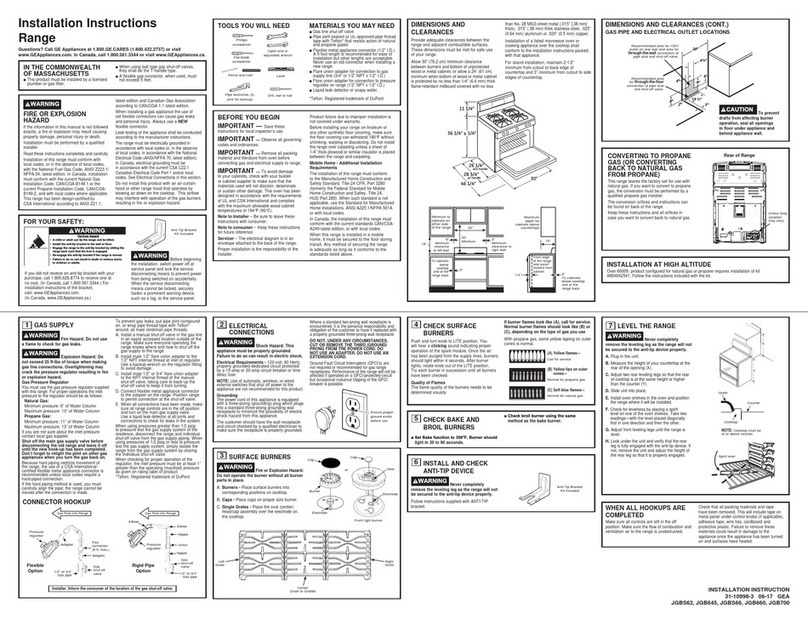
GE
GE JGBS62 installation instructions
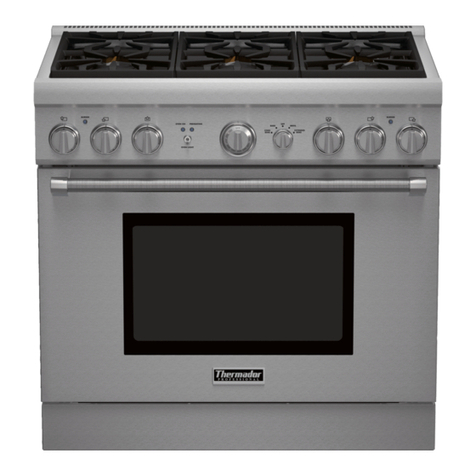
Thermador
Thermador Professional PRO-HARMONY PRD36 installation manual
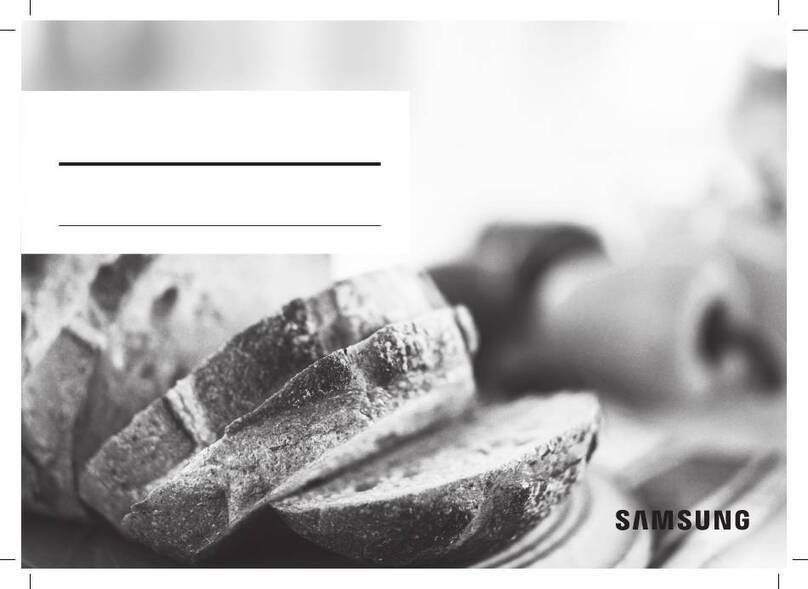
Samsung
Samsung NSG6 8 Series installation manual
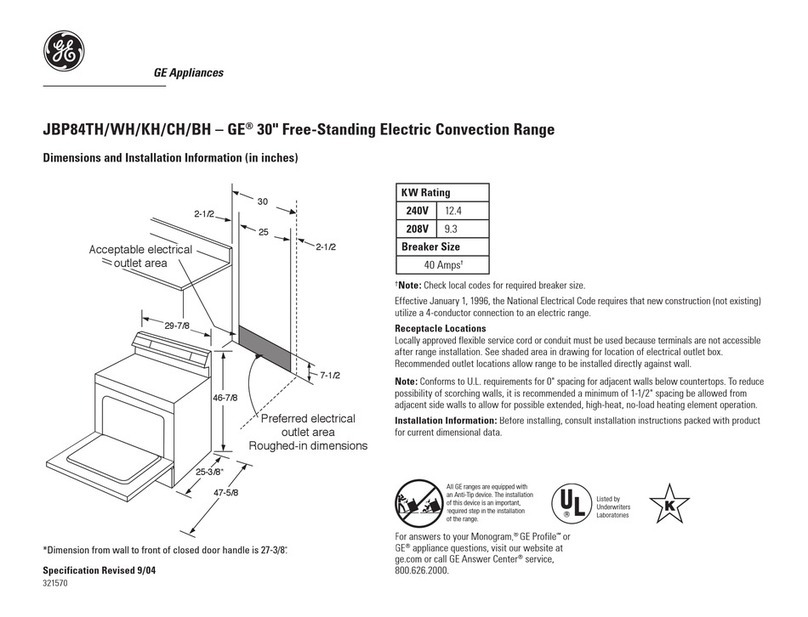
GE
GE JBP84BHBB Dimensions and installation information
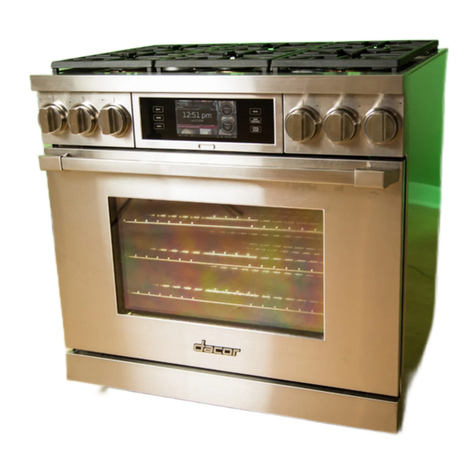
Dacor
Dacor Discovery DYRP48DSNGH installation instructions
